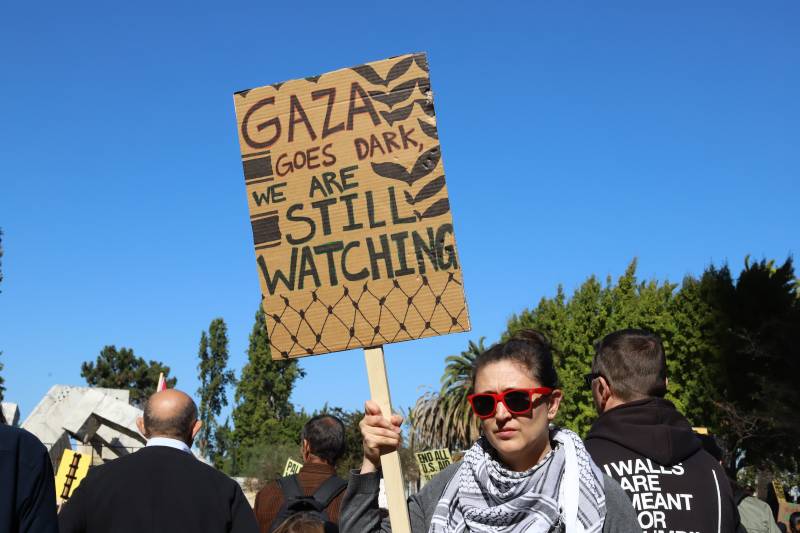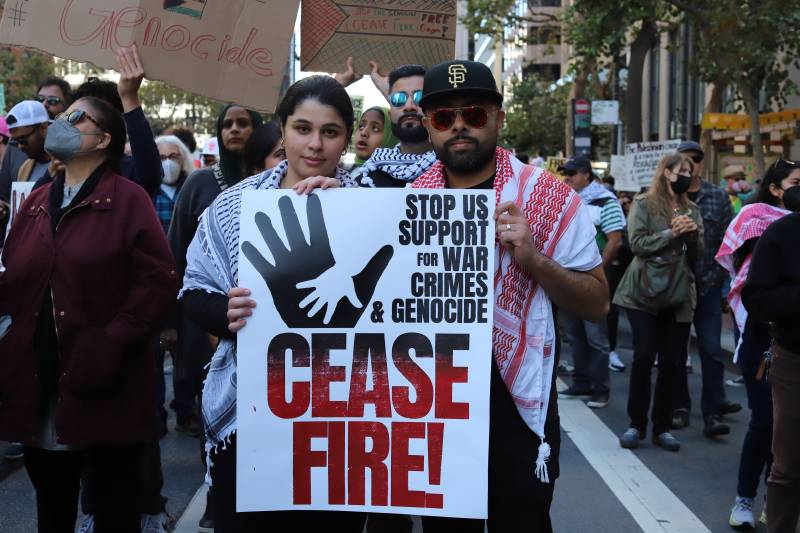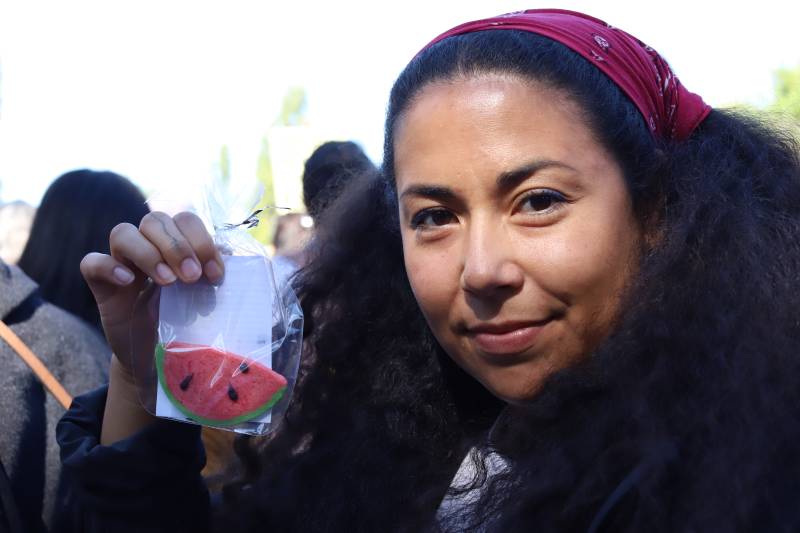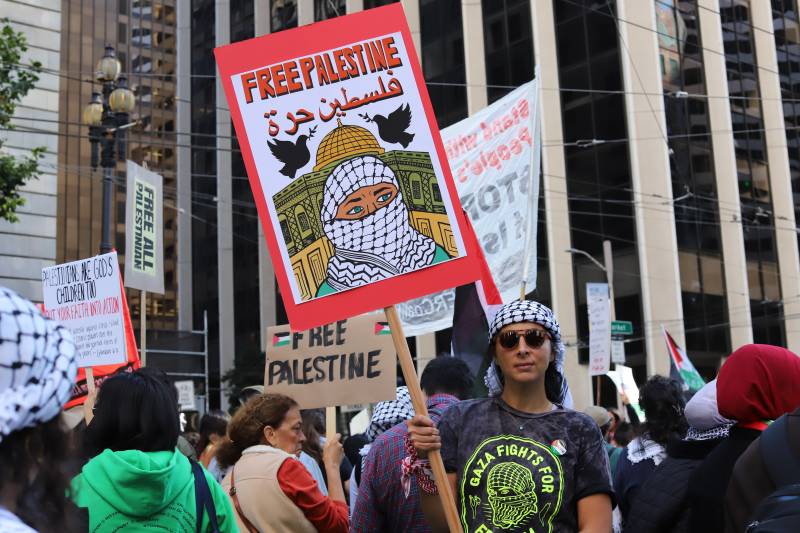At demonstrations throughout the Bay Area, there’s been DIY posters, spontaneous spray paint and artists passing out silkscreen prints expressing rage, grief and calls for ceasefire.
Saturday’s “Stop the Genocide in Gaza” rally at the Embarcadero was no exception, organized by 15 organizations including the Palestinian Youth Movement, the Arab Resource Center and Jewish Voice for Peace. Under clear skies and temperate weather, organizers spoke to a dense crowd of 15,000 demonstrators, according to Wassim Hage, media coordinator for the Arab Resource Center.
“It’s important to emphasize that this escalation in Gaza did not happen in a vacuum,” said Hage. “We know that the violence and all of the killing that we see in Palestine is as a result of 75 years of settler colonial violence, 75 years of apartheid and 16 years of siege by Gaza.”
Demonstrators held hundreds of posters, flags and banners. The immense crowd then marched onto Market Street and later flooded a quarter mile stretch of San Francisco’s Central Freeway, blocking traffic for about 90 minutes.
Bay Area artist and President of the Center for Cultural Power Favianna Rodriguez said that during any political action, it’s important to look at the posters and art of those protesting.
“I think effective protest art is art that names your values and expresses how you feel,” said Rodriguez. “And there are many ways that people can express outrage.”

‘Gaza goes dark, we are still watching’
Andrea Pereira, 39, held a homemade cardboard sign decorated with motifs from the Palestinian scarf known as the keffiyeh with the words, “Gaza Goes Dark, We Are Still Watching.” Pereira said she made the sign after the blackout of communication in Gaza. Israel has targeted and destroyed main telecommunication lines in Gaza according to the United Nations.
“It was really upsetting yesterday when they cut off all communication,” Pereira said. “We’ve all been able to see what’s happening there on social media, and now we can’t, but we’re still holding people accountable.”

Hand-printed silkscreen: ‘Making by hand and sharing is like a prayer’
While some opted for to-the-point signage like one protester who carried a white poster board with the words “Shame On You Biden” written plainly in black marker, others like Rawan Zakout and Francisco Serna held elaborate silk screen prints produced on the spot by San Francisco artist David Solnit. Zakout was wiping her fingertips of loose ink as she marched down Market Street with thousands of other demonstrators.
“We have family in Gaza, and even if we didn’t, we would be out here because this is not humane,” Zakout said. “A lot of our tax dollars go to it, so I feel like this is a good way for me to show what side I’m on.”
Solnit says he printed 150 of the posters with the help of his family amidst a chanting crowd.
“Making by hand and sharing is like a prayer,” he said. “And people can see it was made by our hands, not a machine.”

Watermelon-shaped cookies
One protestor’s art form abandoned pen and paper altogether and instead drew on her culinary prowess as a chef. Marlee Belmonte passed out cookies shaped like slices of watermelon, a symbol of Palestinian resistance with origins in 1967 when Israel seized Gaza and the West Bank and annexed East Jerusalem. After the Israeli government criminalized the Palestinian flag, the watermelon — with its familiar red, white and green composition — took on a new meaning.
“Art as a form of social justice and protest is extremely important because it’s a different way to literally — in this case — digest the fact that we need to put our whole bodies into protesting,” Belmonte said. “We need to give people a bite of sweetness while we’re in this moment, even though it is incredibly painful.”
Handala: A motif of resistance
Another motif of Palestinian resistance known as Handala was painted on a demonstrator’s post board, a character created in 1969 by political cartoonist Naji al-Ali that has come to serve as a representation of identity and defiance. The character is 10 years old and barefoot with his back turned and hands clasped.
“I presented him to the poor and named him Handala as a symbol of bitterness,” wrote al-Ali, who was killed in London in 1987. “At first he was a Palestinian child, but his consciousness developed to have a national and then a global and human horizon.”

Art to express deep care
For Soha Leach, art is a way of expressing deep care during a time of injustice. Leach found an open source illustration online of what she understood to be a Palestinian child backdropped by Al-Aqsa Mosque in Jerusalem with doves flying over their head, and brought it to the protest.
“I have family in Gaza I haven’t heard from,” she said. “And I’m devastated at the entire atrocity, but I’ve been thinking of the children who are born into captivity and destroyed before they even get an opportunity to learn or to love.”
This post was originally published on this site be sure to check out more of their content.






